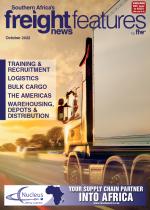Technology is changing the nature of logistics – reducing the cost of transactions and redefining efficiency.Across the sector, more and more executives are realising that information technology is what gives their businesses a competitive advantage.“There has been a surge in popularity for excellent reporting tools such as Power Bi,” says Zander Visser, a project leader at Forte Transport Solutions. “Also, having a central hub where all manner of different software solutions are integrated, is becoming a much sought-after solution. At Forte, we cater for both through our FLOW Portal. It latches onto existing applications and transfers data for a web-based internal dashboard or external client-facing portal view.”Visser says most companies nowadays understand that technology leads to increased productivity in the supply chain while minimising costs and errors. They are fast realising that improved technology solutions take this a step further – such as the central hub concept.This, explains Visser, is where transporters integrate their software such as transport management software (TMS), driver applications, and tracking systems into a central view. “It streamlines the data gathering process, which in turn makes it easier for management to view and pull information. It is now all about access to accurate reporting based on ease-of-use solutions.”Helping to make better decisionsBy gathering data through one’s tracking software or TMS, companies can make better decisions about a variety of things that impact operations daily – from which routes provide the most revenue, to which clients are the most profitable to their business or which drivers put in more work. Even just knowing which vehicles have a higher fuel consumption can make a difference.But, says Visser, it goes further than that. “A Proof of Delivery (POD) is the evidence of the load being delivered, and thus the client is required to pay the transporter. Generally, this type of paperwork would take a long time to receive, as drivers have to return to the depot/office from their trip. Nowadays, we’ve seen an uptick in transporters making use of sign-on-glass functionality, being able to submit the POD electronically (ePOD) to the client, and being paid earlier, leading to an increase in cash f low.”These are all important developments in the South African context, where the cost of logistics remains incredibly high.“Streamlining processes or reporting saves your transport and accounting teams time, and has been proven to save money,” says Visser. “By implementing these processes, companies might be able to save their teams time on operational duties, freeing them up to spend more time catering to other duties. Automating manual processes such as reporting can reduce staff requirements, saving on employee costs.”Optimising routesAnother example is the benefit of providing drivers with well-optimised routes. “There are a lot of bad routes stricken with potholes that can damage vehicles, trailers, or even cargo, again highlighting the positive impact of technology on logistics.”Visser says with the cost of oil and thus fuel possibly one of the biggest challenges facing logistics operators at present, implementing technology solutions that can drive down cost makes sense. “The current high fuel prices are causing transporter rates to spike,” he says. “We have seen several transporting companies not being able to keep up with these hikes and closing dow n.”At the same time, both the domestic and international freight and logistics markets remain highly competitive, especially in the wake of the Covid-19 pandemic. “The market is very competitive, especially when it comes to pricing,” says Visser. “A few cents per ton can sway a potential client’s decision. Companies are therefore increasingly on the lookout for, and keen to implement the latest technological offerings to assist them in providing better services to their clients, and thereby increasing competition in the industry."

